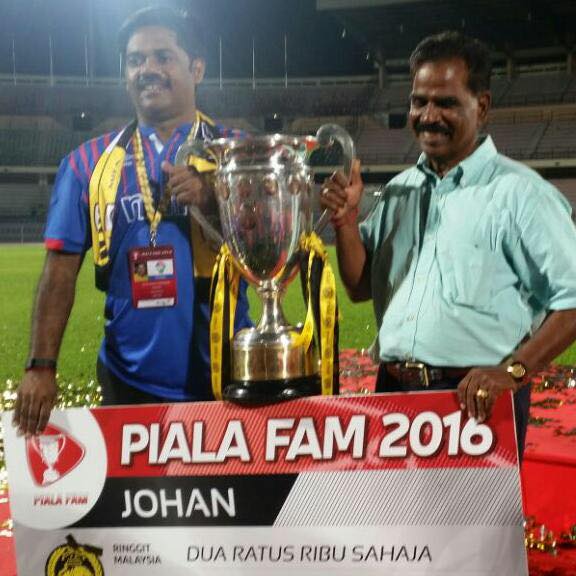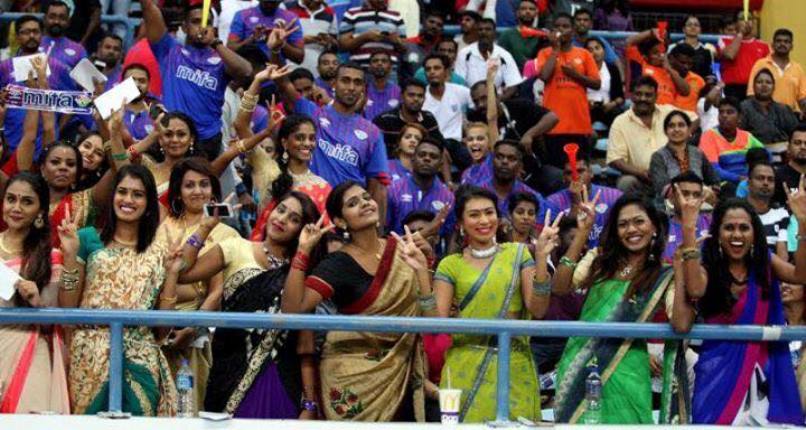
By Suresh Nair
DEEPAVALI will be very special for MIFA (Malaysia Indian Football Association) this year.
The “Festival of Lights” will surely sparkle brighter after winning the FAM (Football Association of Malaysia) Cup for the first time.
Malaysian Indians (MISC-MIFA) clinched their first FAM Cup title after completing a 3-1 aggregate success over the Perak State Economic Development Corporation (PKNP) in the final in Ipoh on Thursday. Leading 1-0 from the first leg in Shah Alam on Oct 20, MISC-MIFA also won the second leg 2-1 at the Perak Stadium.
This ranks as the best-ever “feather-in-the-cap” for the Indian community and to inspire more younger Indian players to use sports as the right vehicle to move up the social and community ladder, says Datuk Karathu Maruthaiah, the iconic Malaysian football hero.
“Definitely, it’s double celebrations for every Indian with the FAM Cup and Deepavali joys this week,” he says. “I have won it as a player for Perak in 1964 and 1965. Kinta India Association was the first Perak club to reach the FAM Cup final in 1987.”
He significantly credits Datuk T Mohan, a rising MIC (Malaysian Indian Congress) politician, for almost single-handedly turning MIFA, an amateur association into a professional entity, in order to inspire the younger generation of the Indian community.
“My heartiest congratulations to Datuk Mohan, we need more rousing leaders like him to use sports as the role-model example to give extra confidence to thousands of Malaysian Indian boys and girls, men and women, and even the older folks, to show that we can be a proud part of multi-racial Malaysia,” added, Datuk Karathu.
Karathu is widely regarded as a special Malaysian sports hero, playing for Malaysia and coaching Negri Sembilan FA, Perak FA in three stints, Malaysia national under-21 football team, Woodlands Wellington FC in Singapore, and Sri Lanka national football team. By coaching Sri Lanka, he was one of a few Malaysians to coach a foreign national team.
He adds about the massive interest of the women folks in the FAM Cup victory: “MIFA is not only changing Indian youths to compete in sports, but changing the mindset of Indian girls to involve in sports. These ladies in colourful sarees were in Shah Alam stadium supporting MIFA. We must keep this new-found passion going.”

MINORITY COMMUNITY
One cannot deny that the marginalisation that Indian Malaysians faced in general, over the past half-century, is structural. They are perceived to be stuck at the bottom of society because of poverty, crime, police violence and social ills. A close Kuala Lumpur journalist friend compared her community to the blacks in the US.
Indeed, among the minority community, the Indians need fiery inspirations like the FAM Cup to boost morale among the younger generation. Leading Malaysian commentator Tony Mariadass, in his regular ‘The Malay Mail’ column, praises the MIC Youth, under Datuk Mohan, for doing their bit, the Malaysian Indian Sports and Cultural Foundation (MISCF), and Malaysian Indian Football Association (MIFA).
He writes: “It would be good to engage former athletes and administrators, too, to helm development programmes or be involved in coaching and sports education. Money should be invested to set up academies to train the best boys and girls and place them in nearby schools where their education can be monitored.”
Mariadass rightly notes that when sports were competed for pride more than payment, a legion of Indian Malaysians have carved their niche in the Malaysian-Singapore Olympic Hall of Fame.
These included the late N. M. Vasagam, late A. Shanmuganathan (A S Nathan) K. Aryadurai, late Datuk G. S. Kler, Tan Sri Dr M. Jegathesan, Datuk Nashatar Singh, Datuk M. Rajamani, G. Rajalingam, T. Krishnan, Lt. Cdr. Karu Selvaratnam, V. Angamah, G. Saravan (athletics), late Datuk Punch Gunalan, Datuk James Selvaraj (badminton), Datuk Dr P. S. Nathan (bowling), late Tiger Aman (boxing), late Lall Singh, Datuk Prof Emeritus Dr A. E. Delikan, Hector Durairatnam, Banarji Nair, Gurcharan Singh (cricket), late Datuk Paul Murugasu, Datuk Peter Velappan, late Edwin Dutton, N. Thanabalan, Datuk M. Karathu, Datuk M. Chandran, Datuk Santokh Singh, late Datuk R. Arumugam, V. Krishnasamy, S. Kathrivale (football), Tan Sri P Alagendra, Datuk G. Vijayanathan, S. Perampalam, Datuk Roy Rajasingham, C. Paramalingam, Datuk R. Yogeswaran, Datuk N. Sri Shamuganathan, K. Balasingam, S. Balasingam, N. Palanisamy, M. Mahedran, R. Rama Krishnan, R. Pathmarajah, Arulraj Michael, N. Palanisamy, Franco D’Cruz, Rani Kaur (hockey), Tan Sri Darshan Singh, M. Kumarasen (cycling), Datuk A. Vaithilingam (schools and athletics), R. Selvamuthu, M. Vasugi, R. Dhanraj (taekwondo) and R. Punaneswaran (karate).
He points out that other Malaysian Indian Olympians include M. Harichandran, late S. Karuppiah, Asirvatham Victor, C. Kunalan, late Dilbagh Singh Kler, R. Subramaniam, G. Rajalingam, S. Sivaraman, P. Peyadesa, B. Rajkumar, Josephine Mary, Annastasia Karen Raj (athletics), G. Ramakrishnan (boxing), late S. Selvanayagam, late T. Nadarajah, late Gian Singh, late P. Sankey, S. Devendran, A. Sabapathy, Kartar Singh, Ranjit Singh, K. Anandarajah, K. Alagaratnam, M. Doraisamy, Tara Singh Sidhu, A. Francis, J. Johnson, Savinder Singh, Kuldip Singh, Harnahal Singh, S. Jeevajothy, Avtar Singh, Anthony Leon Ignas Cruz, Jagjit Singh, M. Suriaprkash, Sarjit Singh, Sukhvinderjeet Singh, Shankar Ramu, M. Sambu, K. Dhamaraj, S. Suria Ghandi, S. Kuhan, M. Kaliswaran, Maninderjit Singh, Aphtar Singh, Jiwa Mohan, K. Keevan Raj, K. Gobinathan (all hockey) and late Moorthy Kanapathy (judo).
SINGAPORE ICONS
From Singapore, the iconic names include C. Kunalan, M. Harichandra, Natahar Bava, Janet Jesudason, Kesavan Soon, P.C. Suppiah, Govindasamy “George” Suppiah, T. Nantha Kumar, Ajit Singh Gill, Anwarul Haque, the late Arumugam Vijiaratnam, the late Kartar Singh and Gopalan Ramakrishnan.
Award-winning writer Mariadass also reminded of the significant contributions of the likes of late Datuk Paul Mony Samuel, Datuk Windsor Paul, Datuk Alex Soosay, Datuk M. Kuppan (football), Datuk Dr Harjit Singh (cricket), V. Nellan, M. Ramayah, P. Gunasegeran (golf), J. V. Jayan (athletics), V. Kalimuthu (football) and Rennie Martin, Anthony Edwin Abraham, V. Subramaniam, K. Jayabalan (athletics) – all of whom earned distinction in their respective fields.
He writes: “When we have had so many sports icons from the Indian community, it is indeed sad to contemplate their evanescence. In the feast celebrating the triumph of light over darkness, let’s not confine to the shadows the worth of a legion of valorous performers and contributors who gave much and asked little.”
In my opinion, now’s the right time for the Indians, on both sides of the Causeway, to fire away and to be the best they can be, academically, sportingly, socially and community work, to show that they can be a strategic component in a multi-racial framework in Malaysia and Singapore.
As a sports journalist for over three decades, I believe sports and politics can work in absolute harmony to raise the civic community. Like this week’s FAM Cup victory and more elected minority positions in the political system, we would be more daring in trying out new ideas, new identities and new configurations of interests in order to foster more diverse political articulations and more pragmatism.
Happy, happy Deepavali!
More bright reasons to celebrate the Indian “Festival of Lights” and to show that Indians can rightly partner the governments, in the spirit of “nambikei” (trust, in Tamil), to bring the Malaysia and Singapore communities to greater heights.
- Suresh Nair is a Singapore-based journalist who believes that Indian sportsmen, on either sides of the Causeway, can continue to be iconic role models for the multi-racial younger generation
































